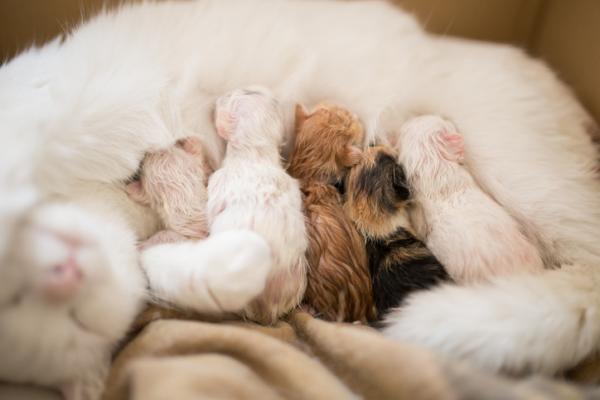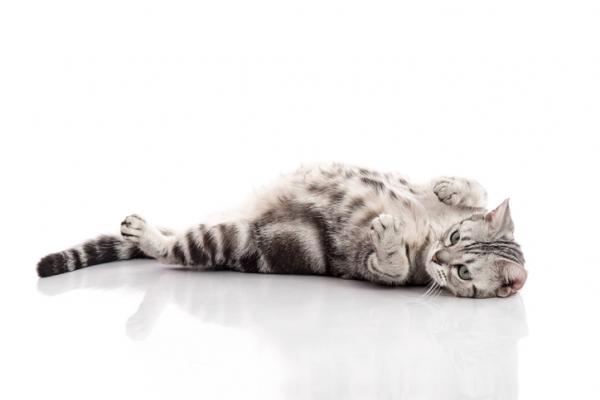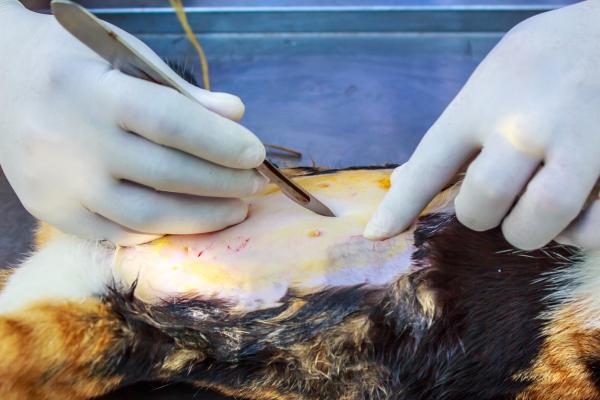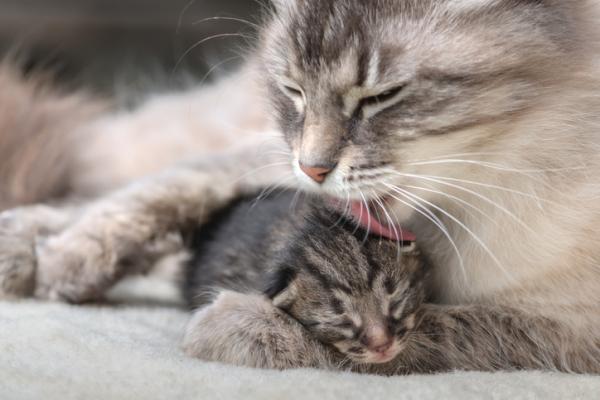4 problems in the delivery of a cat

The birth of a cat it is a moment of joy and excitement, as soon as some playful animals will come into the world that will become excellent pets. This, taking into account that the birth was sought, and not because of an accident. To avoid unwanted births, it is best to sterilize your cat.
Anyway, although the intention is to make the cat a mother and, although the births in these animals are not usually problematic, there may be some Problems in the delivery of a cat like the ones we review in this article.
The reproduction of the cats
The cats, which reach sexual maturity at about half a year of age, are seasonal polyestry animals, that is, they have several jealousies of something less than a week, which are repeated every 2-3 weeks. In principle, this jealousy occurs in the spring, although it depends on the living conditions of the animal, since those who live on the floor have more constant light and temperature conditions and it is more complicated for the cat organism to recognize the change of season.
Gestation lasts, usually, 65 days, although as they say, biology is not an exact science, so this may vary slightly in some cases.
Tips before the delivery of the cat
If you think your cat is going to have puppies, it is advised visit a veterinarian for many reasons.
- First, to make sure that there really is a pregnancy, this can be known with an ultrasound, which is a quick, simple and without side effects, although depending on the character of the animal can be somewhat complicated.
- Secondly, to perform a physical examination to the future mother and Check that you are in good health conditions and can give birth without problems.
- Third, it is interesting to know how many puppies you have inside and if they are alive. An ultrasound is very helpful in these cases.
If you do not know exactly when your cat got pregnant to calculate the date of delivery, by means of an ultrasound, making some measurements, you can predict in a fairly approximate the date on which she will give birth.
In addition to the date, there are other signs that labor is near that can be detected by looking at the behavior of the animal. For example, when the date approaches, the cat may be more emotional, meow constantly or look for a secluded place to make a nest. Another quite specific sign is the drop in temperature: the rectal temperature, which is obtained by introducing a thermometer in the anus, of the cat is reduced to at least one degree when labor is approaching. As the rectal temperature of each animal may vary slightly, it is advisable to measure it regularly several days before to know which one is your particular cat.
The expulsion of the mucous plug, which is detected as a whitish or yellowish flow that leaves the vulva, is a sign that labor is imminent. On the other hand, it is good to have an emergency veterinarian’s phone on hand in case you need your services for the delivery in case something does not go well.

My cat can not give birth, why?
When a cat presents difficulties to give birth and, even, can not expel any of the puppies, in general it is usually due to one of the following most common problems in the delivery of a cat, which must be solved with the help of a veterinarian.
Lifeless puppies
To be able to trigger the birth, the puppies must be alive. If it is not, the birth does not occur and it is necessary to resort to drugs and, if they do not work (something quite likely), to a cesarean section. Check our article on “How to know if your cat needs a cesarean section” to learn how to identify symptoms and act quickly.
Distocias
It is known as dystocias at Complications that make delivery difficult. In cats, that stop several young of small size, they are less frequent than in other animals, that usually light a single bigger breeding like the cows or the sheep. Anyway, yes they can appear, so, if after the signs that we have seen, which show that the birth is imminent, a certain time has passed without any kitten going outside, we should visit a veterinarian, who will try to reposition them and, if this is not possible, perform a cesarean section. Oxytocin is not recommended, a hormone that favors the expulsion of the contents of the uterus in the cat, without having ascertained that the position of the puppies is correct. If not, the uterus will contract trying to expel the puppies and, if this is not possible because one is stuck, the organ can be torn by force. The indiscriminate administration of oxytocin is something that some breeders carry out and it is a very serious error that can have very serious consequences for the mother.
Loss of strength of the uterus
In very long deliveries, in which at the beginning it has been expensive to expel some puppy or in deliveries with a great multitude of them, the uterus can be losing strength as the process advances. There it could be advisable to administer oxytocin, but after having made sure they are placed in a way that they can easily get out. If this does not work, the cesarean section is the definitive solution.
Rest of unexplained placenta
Other problems that may arise are that, after delivery, there is some dead puppy inside the cat or remains of some placenta. Therefore, if you detect that, after delivery, your cat has difficulty recovering from it, and shows fever, signs of weakness or other symptoms of illness, it is advisable to go to a veterinarian to rule out these problems (through a physical examination and an ultrasound) or give them treatment, as the case may be.

How to know if my cat gave birth to all her kittens
In general, the interval of delivery between kitten and kitten is usually not more than one hour, so that if after a couple of hours a new baby does not appear, it is likely that the delivery has finished. In addition, at the end of giving birth, the mother tends to get up and dedicate herself to licking and taking care of her young.
Although in some cases the cats can interrupt the birth and continue after many hours, these are distinguished from a delivery that has not ended, because, when they interrupt the delivery, get up, take care of their puppies, can go to drink, etc. , while If the delivery of a baby has not finished still, the mother will continue lying In the same place. If this is the case of your feline and you suspect that it is difficult to give birth to one of the young, remember that you should go to the veterinarian as soon as possible to confirm or rule out any of the previous problems in the delivery of the cat.
If finally the delivery occurs normally, we recommend consulting our article about care for the mother and her offspring.

If you want to read more articles similar to 4 problems in the delivery of a cat, we recommend that you enter in our section of Gestation.


